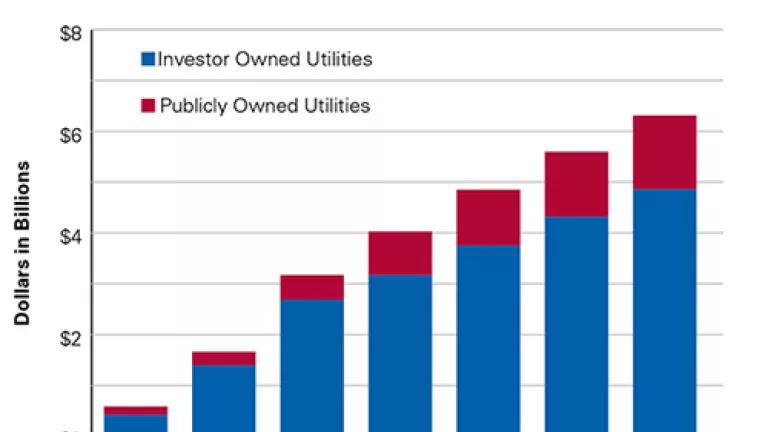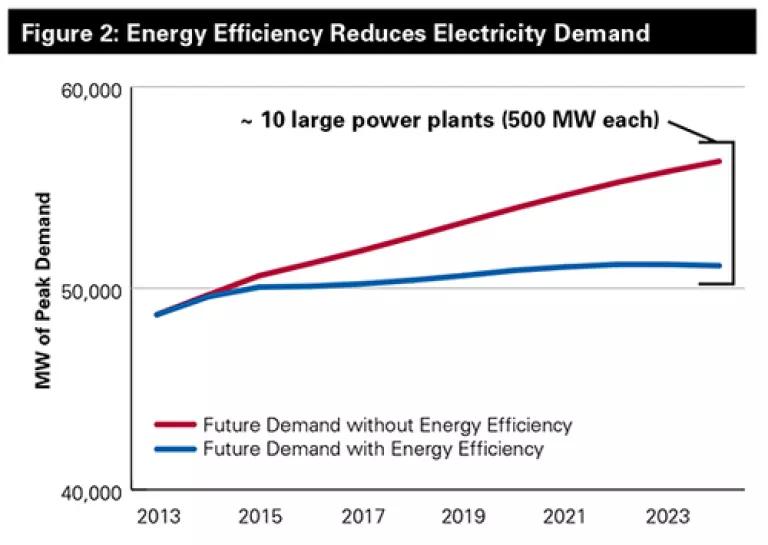
NRDC’s new Fact Sheet released today illustrates the magnitude of energy bill and pollution savings for Californians, thanks to the state’s various energy efficiency programs and codes and standards. But it’s also important that state agencies and the legislature take advantage of this positive momentum to capture even more savings.
Let’s start with the best news: California’s energy efficiency programs have an enviable record of saving utility customers billions of dollars on their energy bills (it’s even more when counting savings from codes and standards).
In just the past two years, these programs have kept an estimated $900 million in customers’ pockets, saved more than enough energy to power all of the homes in the County of Fresno, and cut the equivalent amount of carbon pollution emitted annually from nearly 400,000 cars.
This chart shows the cumulative savings for consumers above the cost of the efficiency programs overseen by both publicly owned utilities (which serve about one-quarter of the state’s electricity demand) and investor owned utilities.
California’s laws and policies spur energy savings
California’s great success in cutting energy waste is due in large part to the commitment from state agencies, utilities, lawmakers, and stakeholders to capitalize on the cleanest, cheapest, and quickest way to save customers money and protect our environment—energy efficiency, or getting the same or better services while using less energy.
California law, which requires utilities to look first at efficiency before considering other sources of energy – such as such as natural gas or solar -- to meet customer needs, is a major driver of the substantial energy savings. Utilities do this by sponsoring programs to lower energy use, such as offering financing to improve the efficiency of buildings and providing rebates for more efficient appliances and gadgets. As a result, the utilities don’t need to purchase as much energy, which also reduces the need for dirtier and more expensive conventional power to provide electricity services like light and heat. In fact, energy efficiency is expected to save enough electricity to avoid 10 large power plants -- and the emissions they would create, which means healthier air and lower customer bills for everyone.

As our Fact Sheet notes, the nearly 50 electric and gas utilities serving California’s homes, businesses, and industries together invest approximately $1 billion annually in hundreds of innovative and wide-ranging efficiency programs. Utilities help customers reduce energy use by using a diverse network of companies, nonprofits, local governments, and industry partners to design and implement these programs.
In part due to the state’s smart efficiency policies (including efficiency programs as well as codes and standards) and the success of the strong and growing efficiency industry, California residents have among the lowest energy bills nationwide. They can also brag that they get twice as many goods and services for every kilowatt-hour used than the rest of the country, while supporting a growing clean energy workforce.
What we need to do next
California has shown great success in saving energy and avoiding polluting power sources, but there is always room for improvement. Additional action is needed for the state to meet its ambitious carbon emissions reduction goals as well as the nation’s Climate Action Plan. In our Fact Sheet, we propose six ways California’s state agencies and the legislature can bring the state’s energy efficiency achievements to even higher levels:
- Ensure that the rules regarding how much efficiency the state relies on as its primary energy resource also align with California’s climate goals;
- Build confidence in energy savings estimates for efficiency initiatives in order to help with utility program planning;
- Create certainty and continuity in program planning by establishing an ongoing funding source for efficiency programs and regular opportunities to improve program design and implementation;
- Reduce the need for new power plants by ensuring that the full effect of energy efficiency program savings are considered when projecting California’s future electricity needs;
- Upgrade existing buildings to reduce energy waste;
- Advance minimum codes to ensure residential and commercial buildings don’t waste energy, and also advance appliance and equipment standards to make sure only the most efficient products are sold in the state.
These strategies would further advance California’s energy efficiency efforts, which is the most cost-effective way to meet the state’s multiple goals of reducing the harmful impacts of fossil fuel power generation on our health and environment, lowering customer utility bills, creating jobs, and increasing our quality of life.
We can rely even more on efficiency to save money and meet both our near-term and long-term climate goals, but only if policymakers, stakeholders, utilities, and other efficiency implementers and partners continue to work together on these important objectives. Let’s focus our efforts on removing the roadblocks that slow the ramping up of efficiency so we can keep the momentum of success going.

